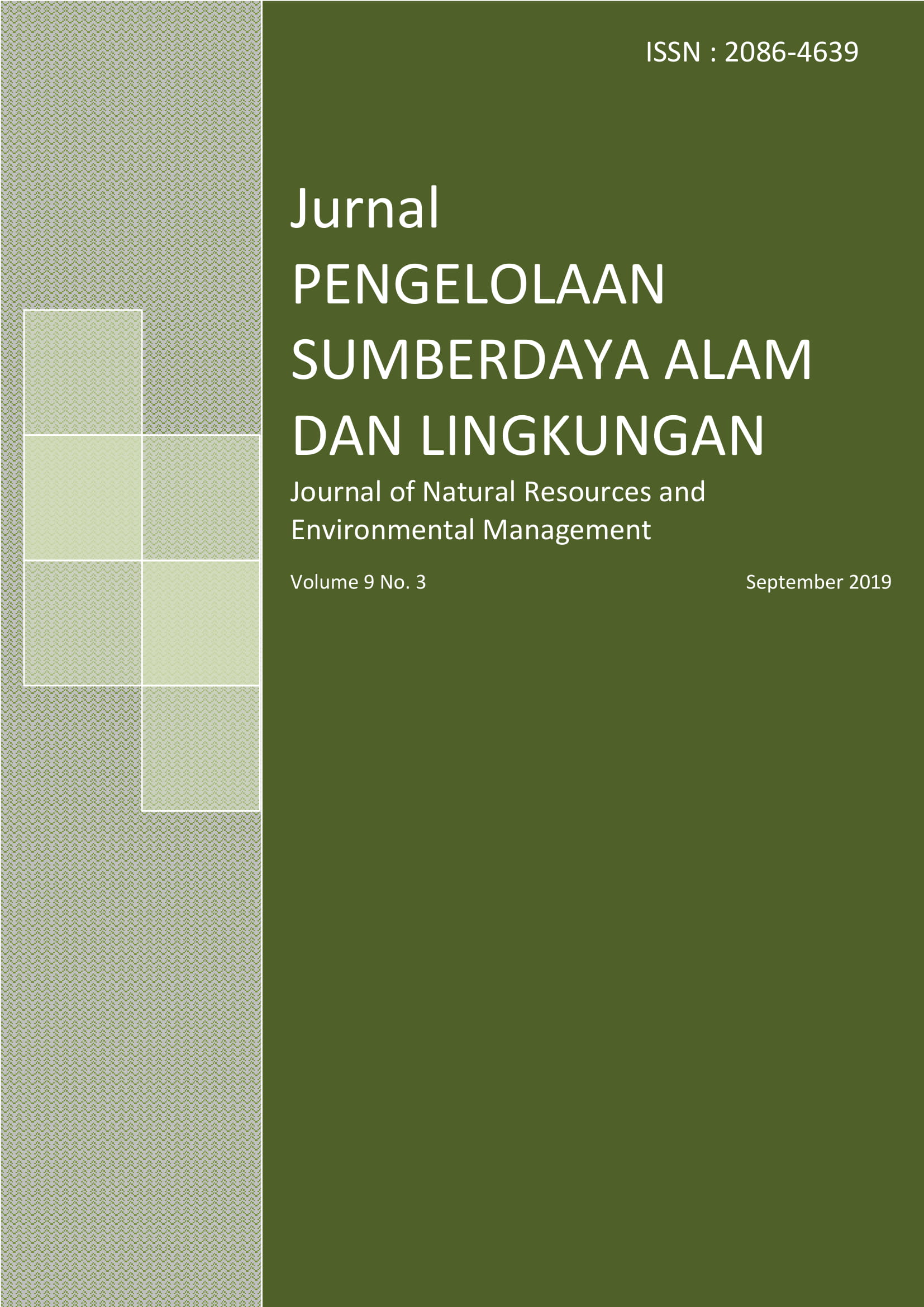KEANEKARAGAMAN SPESIES HERPETOFAUNA PADA BERBAGAI TIPE TUTUPAN LAHAN DI LANSEKAP PERKEBUNAN SAWIT: Studi Kasus di PT. BLP Central Borneo
Abstract
References
Afandi, A.B., 2014. Karakteristik radiasi ma-tahari pertanaman kelapa sawit (implikasinya terhadap iklim mikro dan potensi tanaman sela). Skripsi. Fakultas Matematika dan IPA, Institut Pertanian Bogor, Bogor.
Arista, A., Gunardi D.W., dan Rudi H., 2017. Keanekaragaman jenis amfibi untuk mendukung kegiatan ekowisata di Desa Braja Harjosari Kabupaten Lampung Timur. Biosfera 34(3), pp. 103-109.
Barley A.J., 2014. From microevolutionary pro-cesses to macroevolutionary patterns: investigat-ing diversification at multiple scales in Southeast Asian lizards. Disertasi. University of Kansas, USA.
Darmawan, B., 2008. Keanekaragaman amfibi di berbagai tipe habitat: studi kasus di eks-HPH PT Rimba Karya Indah Kabupaten Bungo, Provinsi Jambi. Skripsi. Fakultas Kehutanan, In-stitut pertanian Bogor, Bogor.
Dewani, AP., R. Boer, N. Jannah. 2014. Analisis Jejak Karbon Agribisnis Untuk Menyusun Ara-han Strategi dan Program Corporate Social Re-sponsibility (CSR). Jurnal Penelitian Sumber Daya Alam dan Lingkungan 4(1): 96-104.
[Dirjenbun]. Direktorat Jendral Perkebunan, 2016. Statistik Perkebunan Indonesia 2015-2017: Kelapa Sawit. [terhubung berkala]. http://dirjenbun.pertanian.go.id. [21 November 2017].
Endarwin, W., 2006. Keanekaragaman spesies reptil dan biologi Cyrtodactylus Cf Fumosus di Taman Nasional Bukit Barisan Selatan Lam-pung – Bengkulu. Skripsi. Institut Pertanian Bo-gor, Bogor.
Fitzherbert, E.B., M.J. Struebig, A. Morel, F. Dan-ielsen, CA. Brulh, PA. Donald, dan B. Phalan, 2008. How will oil palm expansion affect biodi-versity?. Trends in Ecology and Evolution 23, pp. 538-545.
Gillespie, G.R., E. Ahmad, B. Elahan, A. Evans, M. Ancrenaz, B. Goossens, dan M. P. Scroggie, 2012. Conservation of amphibians in Borneo: Relative value of secondary tropical forest and non-forest habitats. Biological Conservation 152, pp. 136–14.
Gunzburger, M.S., Travis J., 2004. Evaluating predation pressure on green treefrog larvae across a habitat gradient. Oecologia 140(3), pp. 422-429.
Hutchinson, M.N., 1993. Family scincidae. Fau-na of Australia. 2, pp. 261-279.
Irawan, R.C.S., 2017. Perbandingan keanekaragaman dan kemerataan herpetofauna di beberapa tipe habitat di lereng utara Gunung Ungaran. Skripsi. Fakultas Sains dan Teknologi, Universitas Islam Negeri Sunan Kalijaga, Yogyakarta.
Irham M., Pungki L., Nur R.I., dan Connie M.S., 2012. Fauna Indonesia. Masyarakat Zoologi Indonesia, Bogor.
Iskandar, D.T., 1998. Amfibi Jawa dan Bali LIPI Seri Panduan Lapangan. Puslitbang LIPI, Bogor.
[IUCN]. International Union for Conservation of Nature and Natural Resources, 2017. Pulchrana baramica. [terhubung berkala]. http://dx.doi.org/10.2305/IUCN.UK.2017-1.RLTS.T58558A113806128.en di [12 September 2017]
Koh, L.P., D.S. Wilcove, 2008. Is palm oil agricul-ture really destroying tropical biodiversity?. Con-servations Letter 1, pp. 60-64.
Kusrini, M.D., 2003. Predicting the impact of the frog leg trade in Indonesia: An ecological view of the Indonesian frog leg trade, emphasizing Java-nese edible frog species. Dalam: Kusrini MD, Mardiastuti A, Harvey T, editor. Conservation of Amphibians and Reptiles in Indonesia. Fakultas Kehutanan, Institut Pertanian Bogor, Bogor.
Kusrini, M.D., 2009. Pedoman Penelitian dan Survei Amfibi di Alam. Fakultas Kehutanan, Institut Pertanian Bogor, Bogor.
Luskin, M.S., dan M. D. Potts, 2011. Microcli-mate and habitat heterogeneity through the oil palm lifecycle. Basic and Applied Ecology 12, pp. 540–551.
Lehtinen, R.M., Ramanamanjato, J-B., dan Raveloarison, J. G., 2003. Edge effects and ex-tinction proneness in a herpetofauna from Mad-agascar. Biodiversity and Conservation 12(7), pp. 1357-1370.
Mac Arthur, R.H., 1972. Geographycal Ecology: Patterns in Distribution of Spesies. Harper and Row Publisher, New York.
McCallum, M. L., 2007. Amphibian decline or extinction? Current declines dwarf background extinction rate. Journal of Herpetology 41(3), pp. 483-491.
Magurran, A., 1988. Ecological Diversity and Its Measurement. Croom Helmed Limited, London.
Mawazin, Atok S., 2013. Keanekaragaman dan komposisi jenis permudaan alam hutan rawa gambut bekas tebangan di Riau (species diversi-ty and composition of logged over peat swamp forest in Riau). Forest Rehabilitation Journal 1(1), pp. 59-73.
Odum, E.P., 1971. Fundamentals of Ecology. WB Saunders Company, Philadelphia.
Qurniawan, T.F., Hastin A. A., dan Rury E., 2010. Studi awal komunitas ordo anura di kawasan ekowisata Sawangan, Magelang, Jawa Tengah. Biosfera 27(3), pp. 119-125.
Santosa, Y., Yohana, dan Wahyuni I., 2017. Keanekaragaman kupu-kupu di berbagai tipe tutupan lahan perkebunan kelapa sawit PTPN V Tamora, Kampar, Riau. Pros Sem Nas Masy Biodiversiti Indonesia, 3(1) pp. 110-116.
Septiawan, H,. Hariadi, M. Thohari. 2014. Ana-lisis Pengelolaan Lingkungan Pabrik kelapa Sawit Batu Ampar- PT. Smart Tbk. Dalam Im-plementasi Indonesian Sustainable Palm Oil. Jurnal Pengelolaan Sumber Daya Alam dan Lingkungan (4)2: 136-144.
Stuebbin, R.C. dan N.W. Cohen, 1997. A Natural History of Amphibian. Princeton University Press, New Jersey.
Urbina-Cardona, J.N., 2008. Conservation of neotropical herpetofauna: research trends and challenges. Tropical Conservation Science, 1(4) pp. 359-375.
Vitt L.J., Caldwell J.P., 2009. Herpetology 3rd edition. Academic Press, Burlington.
Wanger T.C., Iskandar D.T., Motzke I., Brook B.W., Sodhi N.S., Clough Y., dan Tscharntke T., 2010. Effects of land-use change on community composition of tropical amphibians and reptiles in Sulawesi, Indonesia. Conservation Biology 24, pp. 795–802.
Yanuarefa, M.F., Gendut H., dan Joko U., 2012. Panduan Lapang Herpetofauna (Amfibi dan
Authors
Authors who publish with this journal agree to the following terms:
- Authors retain copyright and grant the journal right of first publication with the work simultaneously licensed under a Creative Commons Attribution License that allows others to share the work with an acknowledgement of the work's authorship and initial publication in this journal.
- Authors are able to enter into separate, additional contractual arrangements for the non-exclusive distribution of the journal's published version of the work (e.g., post it to an institutional repository or publish it in a book), with an acknowledgement of its initial publication in this journal.
- Authors are permitted and encouraged to post their work online (e.g., in institutional repositories or on their website) prior to and during the submission process, as it can lead to productive exchanges, as well as earlier and greater citation of published work (See The Effect of Open Access).






